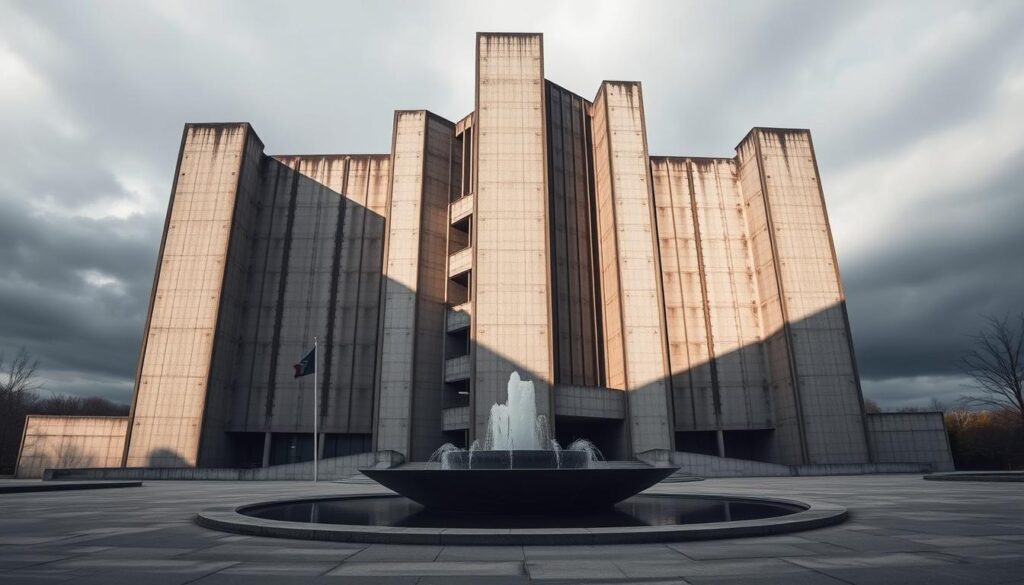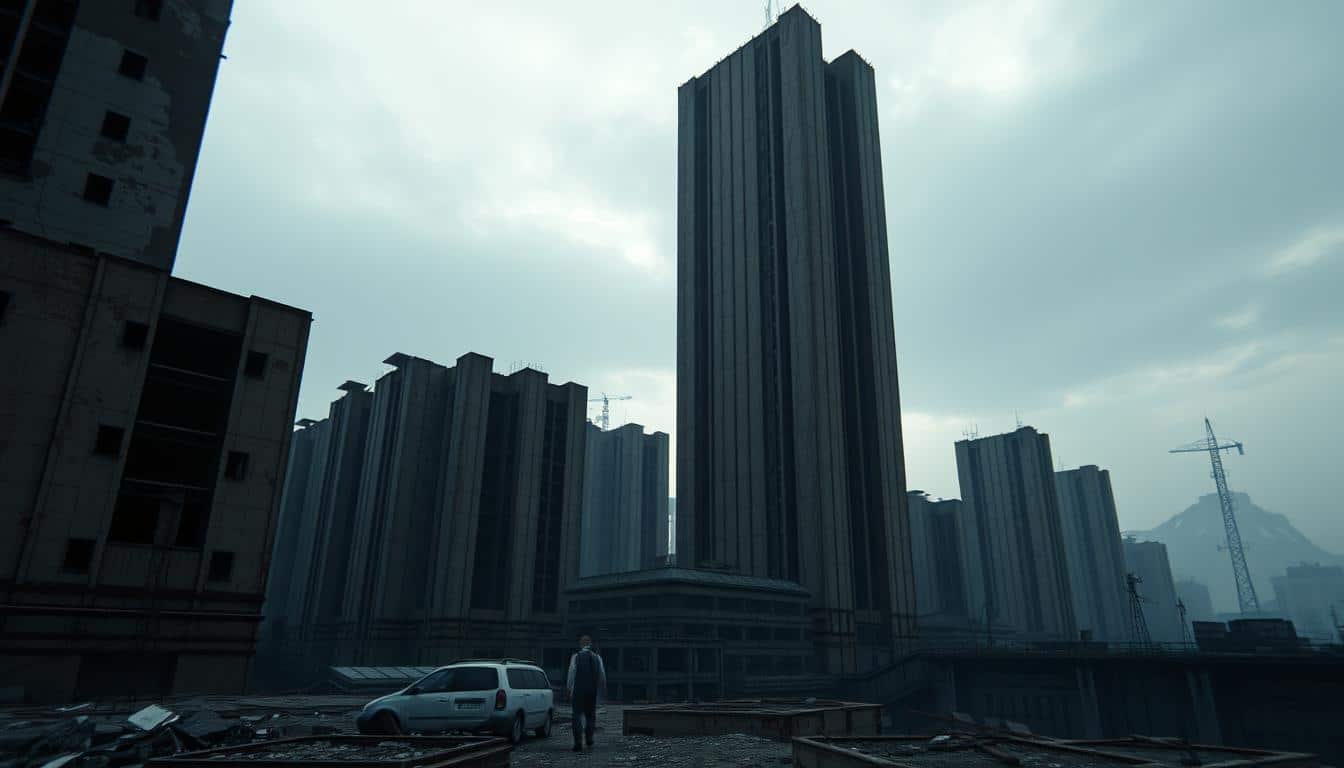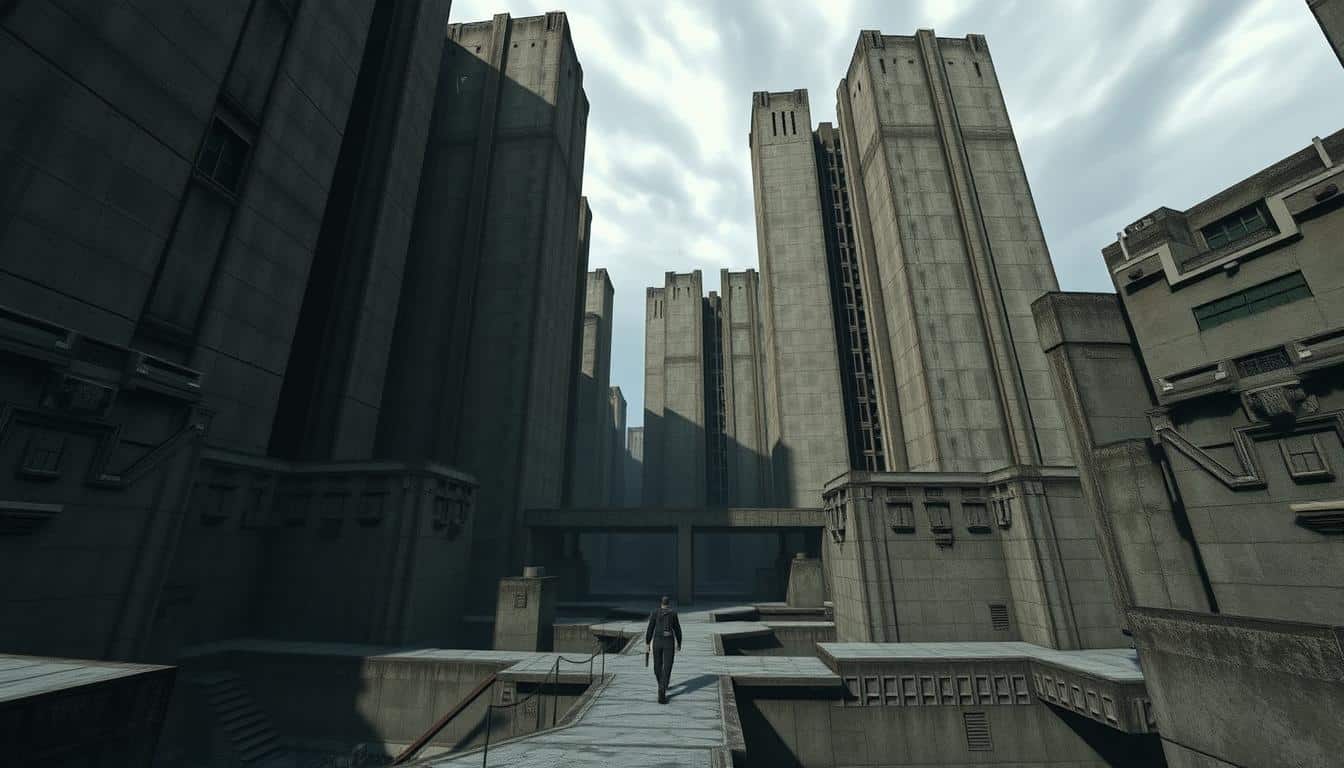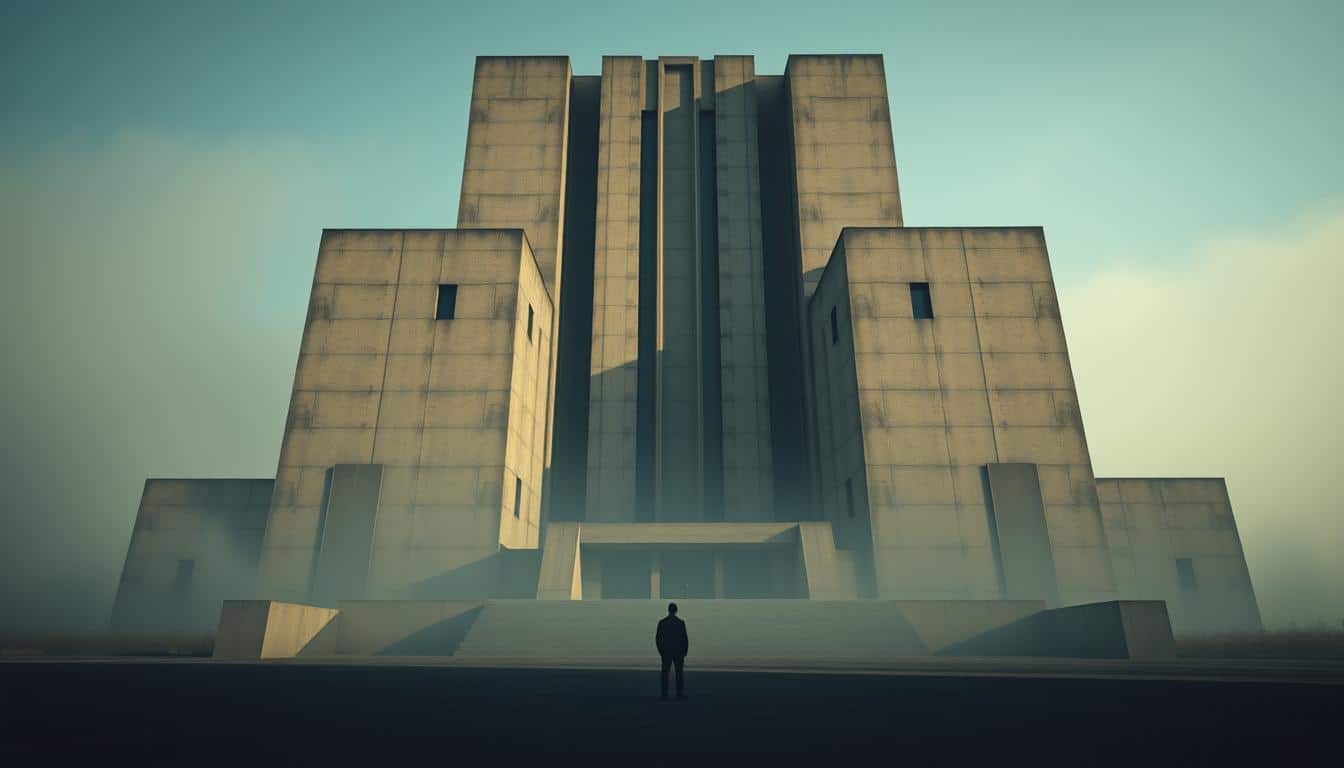Horror games often look to different architectural styles for inspiration. One style that stands out is Soviet brutalism. It’s known for its bold, raw look. Such structures lend themselves well to creating a spooky mood. They add to the tension and fear in horror games. By using brutalist architecture, game creators can shape the game’s atmosphere. This helps bring out strong feelings in the players.
As we dive into how Soviet brutalism influences horror games, we learn more. This style not only makes the game’s world more intriguing but also enriches the story. It invites players into a deeply engaging, spooky adventure.
Understanding Brutalism and Its Origins
Brutalism started in the mid-20th century, becoming popular from the 1950s to the 1970s. It’s known for its bold use of raw concrete. The style’s name comes from “béton brut,” French for “raw concrete.” This style focused on function and showing materials as they are.
After the war, brutalism helped rebuild cities with affordable, practical designs. It took off in Soviet Russia, where architects built to show a new way of living and fairness. Brutalism is known for its simple, stark shapes and finding beauty in raw materials.

Even though some don’t like its looks, brutalism is getting popular again. People are seeing its value in telling the story of architecture. This comeback shows how brutalism fits into today’s digital world and cultural discussions.
Characteristics of Soviet Brutalism
Soviet architecture stands out in the world of design. It features large, block-like concrete buildings that really catch the eye in city settings. These buildings, with their focus on raw materials and use, reflect the Soviet design ideas well. They often look big and simple, making cities feel more the same.
Some things that make this style special are:
- Modular components that create repetitive patterns
- Rectilinear edges that enhance the geometric appeal
- Monochromatic color schemes that reinforce the austere environment
These concrete giants have a big effect on how people feel. They can make one feel trapped or alone, which is perfect for scary movies or games. By looking at Soviet brutalism, we understand its big impact on today’s designs, especially in video games.
Architecture and Video Game Level Design
Architecture and video game design share a deep connection. It makes the game more engaging. Among many styles, brutalist settings in games are very striking. They use bold shapes and bring strong feelings. This way, they create an atmosphere that players really feel.
“Form follows function” is a key idea in architecture. Game designers use it too. They make spaces that are beautiful and improve the gameplay. A broken building might make players feel sad or remember the past. Or a weird structure can make them want to explore more.
Brutalist design, with its concrete look and big forms, changes how players interact with the game. These designs make moving and exploring in the game have more impact on the players. It makes their experience more intense and meaningful.
The Emotional Weight of Brutalism in Horror
Brutalist architecture greatly shapes the feel of horror games. Its stark, hard forms make an atmosphere that makes you uneasy. When you move through areas with cold, concrete buildings, you feel alone and more scared.
Game creators use brutalism’s eerie qualities to make places that feel anxious and hopeless. These heavy settings match the dark stories often seen in horror games. You have to find your way through complex buildings. These places seem almost alive, creating more tension and fear.
This choice of design says something bigger about society, reminding us of strict regimes. In these games, you’re not just playing. You’re seeing a story unfold in the buildings around you. Brutalism in horror games makes us see our smallness against big, powerful structures.
The Impact of Soviet Brutalist Motifs in Horror Game Graphics
The visual styles of Soviet Brutalist motifs deeply influence horror game graphics. They create a special vibe that draws players in. The mix of stark, simple colors and heavy, raw materials brings a sense of real eeriness. These aspects show the weight of oppressive societies, blending well with stories about fear, power, and control.
Visual Characteristics of Brutalism in Horror Games
Brutalism’s unique look makes horror games even more spine-chilling. Key features include:
- Monochromatic color schemes that amplify feelings of isolation.
- Bold geometry that creates a sense of confinement.
- Exposed materials that evoke a raw, unfinished aesthetic, enhancing psychological tension.
Symbolism and Thematic Elements
In horror stories, Brutalist motifs are rich in symbolism. The architecture often mirrors the struggles characters face. It can symbolize:
- The oppressive nature of societal systems.
- Inner turmoil manifesting as physical barriers.
- Existential dread, reflecting on humanity’s vulnerability.
The Intersection of Brutalism and Horror Narratives
Brutalism’s raw look ties deeply with horror stories. It visually shows feelings like being alone and lost. The hard lines of brutalist buildings help tell scary tales. The cold, unwelcoming places make you feel scared and tense. People facing tough times seem even more real against such stark backgrounds.
Horror games use brutalism to make stories scarier. The grim settings mirror what the characters feel inside. As you play, the massive buildings help tell the story. This makes you dive deeper into the adventure.
This blend of building design and story makes horror more intense. Brutalism helps tell deeper stories of fear. Walking through these empty places makes the experience stick with you longer.
Digital Interpretations of Brutalism in Gaming
The rise of digital brutalism in video games shows us a new take on brutalist architecture. Game developers use tech to explore beyond real-world limits. This freedom lets them add surreal touches to brutalist designs, turning them into dynamic digital art.
Procedural generation is key to making game spaces feel vast yet oppressive. Designers use algorithms for surprising, maze-like structures, mimicking brutalism’s disorienting effect. Photogrammetry brings real brutalist details into games, creating unnervingly realistic settings. This mix makes for game worlds that are unsettling and perfect for horror stories.
These digital worlds shape unique player experiences, drawing out deep emotions. The harsh lines of brutalism, combined with spooky sounds and lights, build a tense atmosphere. This approach to game design doesn’t just nod to architectural history. It changes how we experience game spaces, making horror games more immersive.
Prominent Horror Games Featuring Soviet Brutalist Elements
Soviet brutalism draws in gamers with its bold, overpowering looks. It sets the stage for deeply engaging horror games. Control is a great example of this. It uses architecture to make gamers feel uneasy and lost. The game’s main setting is the Oldest House, a place that keeps changing. It bends reality and makes you question what you see.
When looking at Control, we see how buildings are more than just backgrounds. They tell part of the story. The huge, imposing buildings make you feel small and powerless. This adds to the feeling of being under someone else’s control. The game carefully uses these settings to make you feel scared and unsure.
In Control, certain features stand out as top examples of horror. The mix of Soviet looks and spooky themes grabs you. The creepy visuals and the way buildings influence the game create a unique scare. It shows how important architecture is in making a game truly terrifying.
Critiques and Controversies Surrounding Brutalism
Brutalism stands out in architecture, but not always in a good way. Critics link it to feelings of coldness and tyranny. Such opinions come from brutalism’s history with harsh governments. This makes some see these buildings as signs of power, not places for people.
Many find brutalist architecture unsettling with its large, raw concrete designs. These buildings are often at the heart of debates. While some see their cultural worth and call for their conservation, others want them gone because of widespread dislike.
The public’s view greatly affects brutalism’s reputation. Where you live, history, and media stories shape how these buildings are seen. In horror games, brutalist styles create a sense of fear and unease. This shows how deep feelings about these structures go.
Soviet Brutalist Motifs in Horror Game Graphics
Soviet brutalist motifs give horror game graphics a special touch. These designs add to the story and make games more intense. Brutalism’s plain and big look brings feelings of loneliness and ruin. Perfect for scary stories. Its bold forms make the game world feel more frightening.
The game’s setting is key to adding brutalist designs. Eastern European scenes often show off the tough times of the past. This makes the game world seem real yet strange. As players move around, brutalist designs help tell the story.
Games like “SOMA” and “Layers of Fear” mix art and brutalism well. They make players feel strong emotions. Creepy rooms and scary buildings draw players in, making the game more thrilling. This mix of art and history gives players a deeper experience. It shows horror games as a form of art that makes us see things differently.
Future of Brutalism in Game Design
As technology gets better, what’s coming in game design is changing too. We’re seeing more architectural styles like brutalism being used. This trend shows a growing interest in raw, uncut looks. It means we might see brutalist styles in new game types and creative gameplay.
This shift is possible because of better VR and AR tech. Developers can now make games more immersive. They bring players into worlds where the building design itself changes how we play and feel.
Brutalism’s distinct look sets the stage for new ways to see beauty in games. Players will find themselves in places where the buildings tell the story. By blending these buildings with the plot, especially in horror games, it creates intense emotions and keeps players hooked.
Conclusion
The exploration of Soviet brutalist themes in horror game graphics shows a fascinating link that boosts the gaming experience. The architectural styles in these games mirror a dark, oppressive vibe. They add a lot to the story. This mix creates settings with a strong emotional feel, pulling players into stories full of tension and unease.
Brutalist themes are key in shaping the feel of horror games, turning simple designs into sources of fear. Game creators know how these elements trigger strong reactions in players. This makes each scary moment feel even more intense. By using these designs, games go beyond just fun and share deep thoughts on being alone and sad.
In the end, brutalism’s role in game design starts an interesting talk between space and feeling. As creators keep trying new things, the visual and emotional impact of brutalist architecture stays strong. With these elements, future games will keep connecting with players. This shows how important aesthetics are in making game worlds that are hard to forget.



